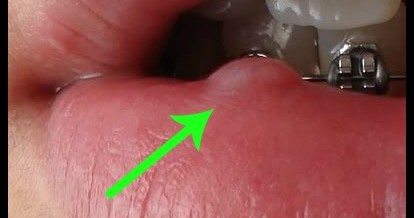
Orthodontic patients frequently assume that every canker sore or swelling in their mouth has to be related to their braces. How can you really tell between a true orthodontic emergency and just a regular sore in your mouth? When should you go see your orthodontist? When should you see your general dentist? When should you see your physician?
Emergencies that are common during orthodontic treatment include trauma from outside the mouth (getting hit in the mouth), trauma from inside the mouth (from the braces themselves), broken parts of the braces themselves (loose brackets and/or bent wires) and unexpected results from the treatment (a tooth moves too far). Each of these emergencies is clearly related to having the braces on your teeth. However, there are other emergencies that can arise that are not necessarily related to the braces or other orthodontic appliances that are in your mouth. These can include fever blisters, canker sores, swollen lymph nodes, blocked salivary glands, as well as regular dental emergencies (abscesses, root canals, cavities, problems with dental work, etc.).
One of the most common lesions that can be mistaken for an orthodontic emergency is a fever blister or a cold sore. These occur in patients with and without braces. Those who got them before they had braces will usually keep getting them during treatment. Rarely do patients who have never had a blister previously start getting them just because they have braces. They are caused by the herpes simplex type 1 virus and an outbreak usually occurs on or around the mouth and typically heals within two to three weeks. They can be a lifelong irritant, since the virus remains dormant in the body throughout your life. Outbreaks can be triggered by stress, overexposure to sunlight, hormonal changes, trauma to the skin or a weakened immune system. Over the counter remedies such as Abreva are the treatments of choice.
Another very common lesion mistaken for an orthodontic emergency is the garden-variety cold or canker sore. Although the braces can irritate the skin inside the mouth, canker sores occur in mouths with braces as well as those without. One helpful clue is the location of the canker sore relative to the braces. If it perfectly aligned with a part of the braces, they may have actually been the cause of the sore. Many times however, they appear far away from the braces in areas such as deep inside the lip, under the tongue, or inside the cheeks. If they appear adjacent to the metal, wax placed over the irritant and some type of numbing cream (over the counter) will make things comfortable until the sore heals on its own. If there is an obvious structure causing the sore, you should have your orthodontist take a look. In general, canker sores will go away on their own without any kind of professional care needed. However, canker sores may be annoying and irritating, so here are a few home remedies to consider:
• Rinse your mouth using salt water
• Use over-the-counter medications such as Anbesol
• Eat foods that are soft
• Avoid spicy/acidic foods and beverages
For serious canker sores or persistent re-emergence of canker sores, sometimes your physician can prescribe a professional-strength medication. In most cases, this will involve the use of a special corticosteroid ointment to apply to the canker sore or a rinse for the mouth that helps remove harmful bacteria and microbes that may contribute to the irritation or formation of the canker sore.
Swollen lymph nodes (usually in the neck) indicate that there is an active infection somewhere in the head and neck region. It might be as simple as acne on the face, but all such swellings should be also be evaluated by your orthodontist and the corresponding infection treated.
The mouth is full of tiny glands that produce saliva. Dry the inside of your lip with a piece of tissue in front of a mirror and watch the saliva slowly begin to bead up! On rare occasions (with or without braces), the ducts of these minor salivary glands get plugged up. The result is a swelling or bubble inside the lip or under the tongue. Your dentist treats this by creating an opening so the saliva can drain and the area can heal. Your dentist should be consulted in these cases so that he can rule out more dangerous growths that just happen to appear while your braces are on.
The final category of non-orthodontic emergencies that occur in the mouth during treatment are normal dental problems. These include decay, gum problems and restorations (fillings, crowns and veneers) that break down. You should continue seeing your family dentist at regular intervals during orthodontic treatment (at least every six months!). If your orthodontist notices a problem with the teeth themselves, he will refer you to your family dentist for repair.
By Dr. Gary Reichhold
MAR

About the Author:
Dr. Gary Reichhold and his partner Dr. Stephen Tanner have been proudly serving families in Concord, Walnut Creek, Clayton, Pleasant Hill and the surrounding communities for over 20 years. Their office is conveniently located in central Contra Costa County and their experienced team is committed to providing you and your family with exceptional orthodontic care.